The compactness of the bunch facilitates the growth of Botrytis, one of the main health problems of the vine; the market appreciates seedless varieties, ...
Jose Miguel Martínez Zapater from the Institute of Vine and Wine Sciences, Logroño, La Rioja, explained that somatic variation contributes to phenotypic variation in woody species such as the vine, whose traditional varieties have been vegetatively propagated for centuries. His conference, titled “Somatic Variation in the Vine: New Biological Functions for Genetic Improvement and Gene Editing,” opened Post2024.
Phenotypic variation among plants derived from the same original seed results from somatic mutations that affect different cells and cell lines of the plant, which can be maintained stably through vegetative propagation. Somatic variants have been described in the vine for multiple plant traits, and during the process of gamete generation, these random mutations can be sexually transmitted. This variation has been important during domestication, and the existence of collections that gather varieties is essential to take advantage of this wealth of traits.
Zucchini More Resistant to Cold Damage and with More Nutritional Compounds
In 2018, the complete genome sequence of Cucurbita pepo was published. Since then, thousands of genomes and transcriptomes have been resequenced, and functional genomic tools have been developed, significantly advancing the knowledge of the genetic control of agronomically important traits.
The research group led by Manuel Jamilena Quesada at the University of Almería is using genomic and transcriptomic tools to identify QTLs, genes, and allelic variants responsible for zucchini quality. As a result of these efforts, a functional genomic platform in C. pepo has been created, composed of an EMS (*) mutant population with 3,700 independent M2 lines in the MUCU16 genetic background.
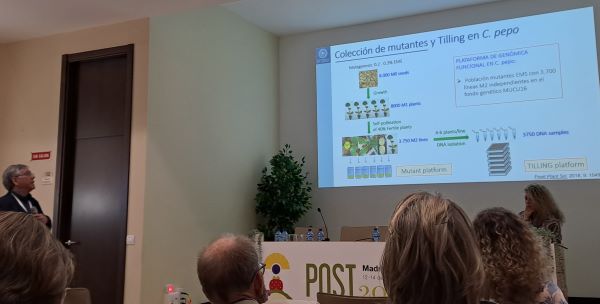
The collection of mutants developed by Manuel Jamilena, UAL, and his research group.
Through direct screenings, accessions and mutant lines have been identified whose fruits are more tolerant to cold damage or accumulate more carotenoids or sugars in the skin. QTLs and the genes responsible for the phenotypes have been detected.
In reverse genetics approaches, they identified a set of differentially expressed genes in the fruits of higher and lower quality and subsequently detected mutations in these genes through whole genome sequencing of the mutant collection (Tilling by sequencing).
These mutants are not only useful in basic studies of functional genomics but can also be an important source of traits of interest for crop genetic improvement. Based on projects where they work with seed companies, traits of interest and linked or responsible markers are transferred for the development of new zucchini hybrids.
(*) EMS
Tools for Developing New Seed-Propagated Varieties
Also focused on genetics was one of the invited conferences, in this case by Antonio Granell Richart from the Plant Genomics and Biotechnology Group, Institute of Molecular and Cellular Biology of Plants (IBMCP-CSIC-UPV), Valencia. In this case, the chosen plant, the tomato, is seed-propagated. The speaker reviewed his laboratory's contributions to developing knowledge, materials, and tools to create new varieties that provide fruits with desired characteristics regarding nutritional and organoleptic features.
To achieve this, MASPB (*) and biotechnology were combined, including the identification of genomic regions/QTLs (**) associated with and eventually the causative genes of the phenotype. Some of these studies have been conducted in collaboration with companies in the framework of collaborative projects, or the knowledge/materials have been licensed to companies.
The speaker also referred to the legal situation in the European Community regarding NGTs, new genetic techniques whose approval is crucial for sector companies, but which have not yet been approved for agronomic use.
(*) MASPB (Marker Assisted Plant Breeding)
(**) QTLs are quantitative trait loci
Fruits and Vegetables as Sources of Polyphenols
The objective of a fruit or vegetable on the consumer's table is pleasure, while also being products of nutritional quality, whose contribution goes beyond energy. Sonia de Pascual and Teresa Fernández from the Department of Metabolism and Nutrition, Institute of Science and Technology of Food and Nutrition (ICTAN-CSIC), explained the role of polyphenols in human nutrition in their conference “Effects of Polyphenols in Fruits and Vegetables on Consumer Health.”
Polyphenols derive from the secondary metabolism of plants and comprise a broad group of compounds, including phenolic acids, stilbenes, and lignans.
The effects on consumer health are, on one hand, due to their intrinsic biological activity through different fruits and mechanisms that have been demonstrated at the cardiovascular, neurocognitive, and intestinal microbiota regulation levels, depending on the polyphenol group. On the other hand, polyphenols interact with other components of plant products and the diet in general, protecting nutrients from oxidation and degradation, or interacting with toxic compounds by blocking them and inhibiting their action.
Polyphenol levels in fruits and vegetables are modified by multiple factors, from variety to agronomic factors, degree of ripeness, or the presence of biotic or abiotic stressors. Various postharvest strategies aim to increase the content of these compounds, promoting their biosynthesis, to improve either the shelf life of those products or to “functionalize” fruits and vegetables to increase their added value.
In both cases, whether deliberately or not, an increase in potential health benefits for the consumer is achieved.
The Importance of Accurate Diagnosis
Postharvest physiological alterations are the consequence of different abiotic stresses with symptomatology that can lead to inaccurate diagnoses. María Teresa Lafuente Rodríguez from the Department of Food Biotechnology, Institute of Agrochemistry and Food Technology (IATA-CSICM), in her presentation “Tolerance to Abiotic Stresses Responsible for Postharvest Physiological Alterations,” explained that etiological distinction and classification can be erratic when different stresses result in similar symptoms.
Ma. Teresa Lafuente emphasizes the importance of being able to differentiate between symptoms that can be very similar. José Manuel Palma, from the El Zaidin Experimental Station, presides over the table; he is a recent "addition to postharvest" and presented an interesting study on the interaction of nitric oxide (NO) and hydrogen sulfide (H₂S) in the ripening and postharvest of pepper fruit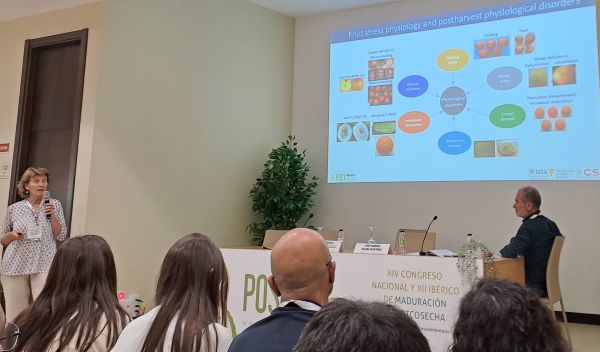
Ma. Teresa Lafuente emphasizes the importance of being able to differentiate between symptoms that can be very similar. José Manuel Palma, from the El Zaidin Experimental Station, presides over the table; he is a recent "addition to postharvest" and presented an interesting study on the interaction of nitric oxide (NO) and hydrogen sulfide (H₂S) in the ripening and postharvest of pepper fruit
Cold damage and, to a lesser extent, dehydration (water stress) have been classic study subjects. However, knowledge about the contribution of energy deficit (fasting) to the development of physiological alterations and the mechanisms involved is scarce, despite the stress generated by the lack of nutrient supply upon harvesting the fruit. Moreover, this stress is exacerbated under pre/postharvest conditions that increase fruit respiration.
The presentation provided an overview of fruit tolerance to the mentioned stresses, highlighting the importance of preharvest factors, conditioning treatments that induce tolerance to these stresses, and differentiating between early and late responses to them. Oxidative stress and the degradation of lipids and proteins, which affect membrane integrity, often participate in the development of various postharvest alterations regardless of the stress that produces them.
The researcher also emphasized the concept of cross-adaptation to stress in plants due to its importance in developing conditioning treatments that reduce postharvest damage by applying prior non-lethal stress to the one causing damage.
Requirements for Valorizing By-products
The circular economy involves being able to take advantage of the by-products from various horticultural industries. Francisco Artés Hernández from the Postharvest and Refrigeration Group, Department of Agronomic Engineering, and Institute of Plant Biotechnology at the Polytechnic University of Cartagena addressed this topic in his conference “Valorization of Horticultural By-products through Sustainable Green Technologies,” highlighting the need to also consider energy efficiency and consumption, cost, and environmental impact that lead to sustainable utilization of by-products.
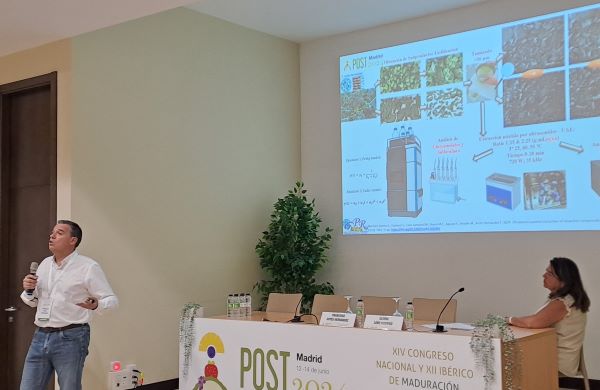
Francisco Artés Hernández highlights the importance of evaluating, among other factors, energy consumption when revaluing waste
The amount of by-products generated by the horticultural industry can reach up to 50% of the raw material, containing abundant bioactive compounds, primarily polyphenols, carotenoids, pectins, and fatty acids.
Given the growing interest in promoting health through food, the industry is focusing on the sustainable revalorization of these by-products and harnessing the phytochemical compounds for the development of new “clean label” foods.
There are various extraction techniques, ranging from conventional thermal methods to innovative approaches like microwave-assisted extraction. However, the thermal instability of nutraceutical compounds, which reduces their content, has led research towards “green” non-thermal technologies, such as ultrasound-assisted extraction or enzymatic extraction, supercritical fluids, high hydrostatic pressure, pulsed electric fields, fermentation, and maceration. There is also a push for the use of ecological solvents like water or organic solvents.
Concentrated extracts (powder or liquid, encapsulated or not) can be incorporated into food matrices as a good tool to preserve and supplement foods while improving their techno-functional properties.
How to Avoid and Detect Contaminations in Production and Processing?
In recent years, leafy vegetables have been the minimally processed products responsible for the highest number of outbreaks and product recalls due to contamination risks from Listeria monocytogenes and, to a lesser extent, Salmonella spp. The conference by María Isabel Gil Muñoz from the Microbiology and Quality of Fruits and Vegetables Group, CEBAS-CSIC, analyzed the “Control of Microbiological Risks Associated with New Production and Processing Systems.”
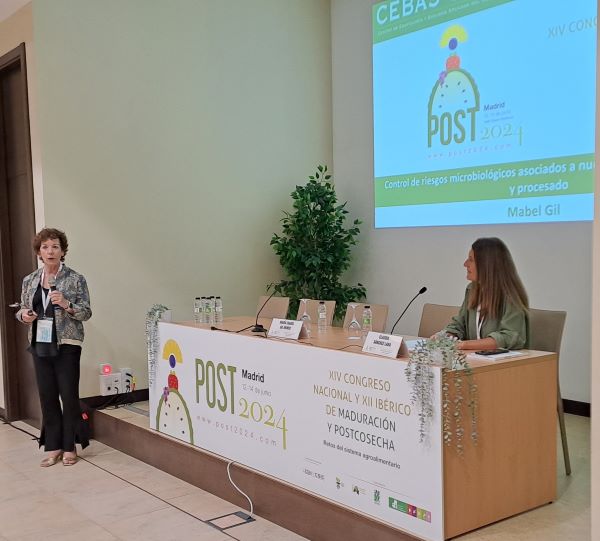
Ma. Isabel Gil emphasizes the need for improvement in the design of certain areas that tend to accumulate water
The vegetables marketed as minimally processed are produced in CEA (*) – hydroponic cultivation with nutrient solutions, artificial substrates, and soil. The conference discussed possible sources of risk and transmission routes in these three systems, where cultivation practices and harvesting are automated.
Additionally, a study conducted in three processing plants for minimally processed products was presented to characterize prevalence patterns and contamination through systematic environmental monitoring (EM) sampling.
In this study, conducted after production and just before cleaning, a very high prevalence was observed compared to sampling done after the cleaning and disinfection of the production line. The main objective was to identify contamination niches that could cause cross-contamination with the final product.
In the three samples taken from each processing plant, contamination niches were detected on surfaces not in direct contact with food (non-FCS), which could facilitate the transfer of L. monocytogenes to surfaces in direct contact with food (FCS).
None of the isolates showed resistance to the biocides used by the industry. This indicates that the presence of L. monocytogenes after cleaning and disinfection could be related to the need for improvements in the design of certain areas that tend to accumulate water, such as floor cracks, wall joints, and drains.
Polyamines in Pre-harvest That Reduce Cracking
The existence of polyamines (PAs) has been known since 1678 when they were discovered by Anton van Leeuwenhoek, the “father of microbiology.” These are organic compounds found in all living beings, including plants, and are involved in various biological and physiological processes such as the growth, ripening, and senescence of fruits. Additionally, PAs can modulate the plant's response to various types of abiotic and biotic stress.
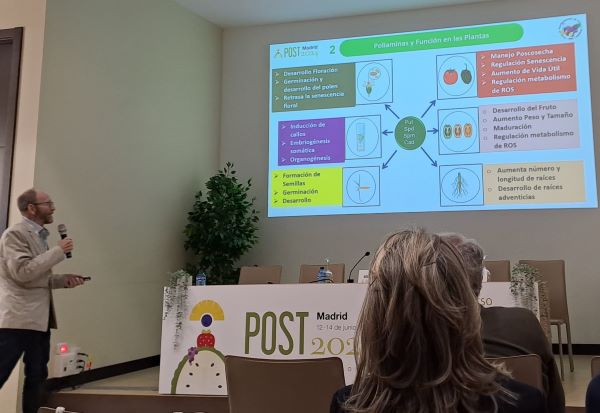
Daniel Valero explains the effects of polyamines applied in preharvest.
Daniel Valero Garrido from the Miguel Hernández University, Alicante, in his conference “Application of Polyamines in Pre-harvest on the Physiology of Ripening, Production, and Quality of Non-climacteric Fruits,” explained that most research with these compounds has focused on their postharvest application to reduce cold damage. It is known that when applied at this time, PAs are effective in modulating the ripening process, delaying senescence, and maintaining organoleptic quality parameters.
The speaker explained the results obtained by applying PAs in pre-harvest. The effects of pre-harvest application of PAs (putrescine and spermidine) at different concentrations on the yield of cherry, pomegranate, and blood orange crops, all of which are non-climacteric fruits, were analyzed. Among the effects obtained by applying these two PAs is the reduction in cracked fruits in susceptible species; for the future, there is a plan to delve deeper into the physiological mechanisms involved.
Vis-NIRS to Determine the Optimal Harvest Date in Oranges and Mandarins
The IGP Algarve Citrus in Portugal is characterized by harvesting after the minimum acceptable date, which results in greater organoleptic quality. However, Ana M. Vicente Cavaco from the Center for Electronics, Optoelectronics, and Telecommunications (CEOT), University of Algarve, explains in her conference “Don Quijote of Vis-NIRS (*) and the Intelligent Prediction of the Optimal Harvest Date in Algarve IGP Citrus,” that climate change has caused severe water stress and high temperatures in that region.
Maintaining quality and production sustainably requires intelligent management of orchards. The determining factor for fruit quality in the markets is based on the ability to predict the optimal harvest date (DOC), which follows minimum values of juice content, soluble solids content (SST), and maturity index (IM).
These parameters are determined through standardized and destructive methods, in small samples from each orchard. The objective of this study was to apply visible and near-infrared spectroscopy (Vis-NIRS) to predict the ripeness status of orange (Citrus sinensis L. Osbeck 'Newhall') and mandarin (Citrus reticulata Blanco x Citrus sinensis (L) Osbeck 'Ortanique') in four georeferenced orchards with different edaphoclimatic conditions.
The fruit spectra were acquired directly from the tree using a portable VisNIRS system. After correlating using PLS, with the respective parameters determined by standardized methods, calibration models were constructed, except for juice content.
The model with the highest predictive capacity was obtained for TSS, followed by IM in orange, and the opposite for ‘Ortanique.’ The worst model was obtained for firmness.
The possibility of increasing the robustness of the models in real-time, in the same commercial season, through recalibration techniques (bias and spiking), and over the years with the inclusion of new datasets from different orchards was demonstrated. The use of neural networks and deep learning enhances the amplification of the model’s performance by integrating larger databases and/or those resulting from environmental detection in orchards. Accepting the limitations of this technique, the great challenge of Vis-NIRS lies in its implementation in the management routines of producers and cooperatives.
(*) Visible near-infrared reflectance spectroscopy
Edible Coatings and Biodegradable Packaging
Sustainable packaging is part of the European Green Deal and plays a key role in the social and political strategy of the EU. María Bernardita Pérez-Gago from the Postharvest Technology Center, Valencian Institute of Agricultural Research (IVIA), in her conference “Edible Coatings and Biodegradable Packaging as Sustainable Packaging Strategies to Reduce Quality Losses in Fruits and Vegetables During Postharvest,” emphasized that biodegradable and sustainable food packaging materials based on biopolymers like proteins, polysaccharides, and biopolyesters have helped industries tackle these challenges.
In the case of fruits and vegetables, films and edible coatings formulated from biopolymers such as proteins and polysaccharides, as well as other natural compounds or GRAS (generally recognized as safe) substances, have garnered much interest at both scientific and industrial levels as a safe technology with low environmental impact.
These can provide a barrier to gases and water vapor, reducing transpiration and the metabolic activity of the fruit by creating a modified atmosphere. They also allow the incorporation of active compounds with antimicrobial and/or antioxidant capabilities or even aromas and nutrients that address other quality aspects, such as physiological alterations, sensory attributes, nutritional aspects, and food safety, offering new opportunities in the postharvest of fresh and minimally processed fruits and vegetables.
In this regard, the development of edible coatings with antifungal activity for whole fruits and vegetables made from biopolymers such as chitosan or Aloe vera, which have some antifungal capacity, or by incorporating antifungal ingredients into formulations, such as some organic and inorganic salts, essential oils, plant extracts, biological control agents, etc., is one of the areas of most scientific interest in recent years due to the need for alternatives to synthetic chemical fungicides.
Similarly, the use of edible coatings to extend the shelf life of minimally processed products is one of the most novel and promising techniques. In these products, most studies have focused on developing coatings with antioxidant and/or antimicrobial activity by incorporating food additives or designing packaging that allows controlled release of the active substance.
On the other hand, current strategies within the scenarios of the circular economy are directing studies toward obtaining biopolymers, functional bioplastics, and advanced materials obtained from by-products or food waste generated in the agri-food industry, thus contributing to the sustainability of the food chain.
About Post 2024
The Post2024 Congress took place from June 12 to 14 in Madrid, combining the XIV National Congress and the XII Iberian Congress on Ripening and Postharvest, with participation from mainly foreign researchers, primarily from Portugal, but not exclusively.
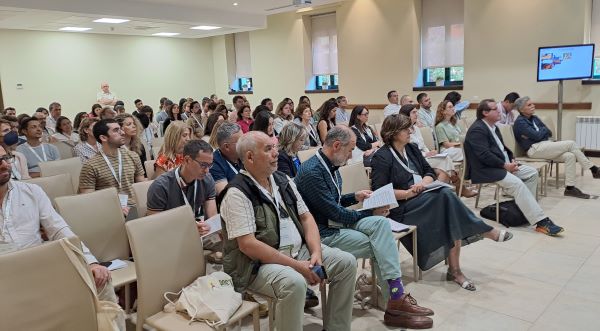
Attendees at Post 2024 in the Espacio Sala Maldonado, Madrid
This event highlighted a growing awareness that "postharvest starts in the field," as evidenced by the presence of specialists who have not typically participated in postharvest meetings before. The organization was led by the Biotechnology and Postharvest Quality Group (POSTBIOTEC), part of the Institute of Science and Technology of Food and Nutrition (ICTAN-CSIC). Carmen Merodio Moreno, head of POSTBIOTEC, presided over Post2024.
Both the Abstract Book and the Full Papers Book are available on the Congress website, https://post2024.com/.
The organizers of Post 2024 kindly provided space for the presentation of the journal "ACTUAL Poscosecha," which will be published annually by Poscosecha.com, featuring research papers on the topic. In the image below, our colleague Claudia Conesa explains the characteristics of this publication, with its first issue set to be presented at the Fruit Attraction 2024 fair (October 8 to 10, 2024, in Madrid) and this year exclusively sponsored by Citrosol, where the presentation will take place.
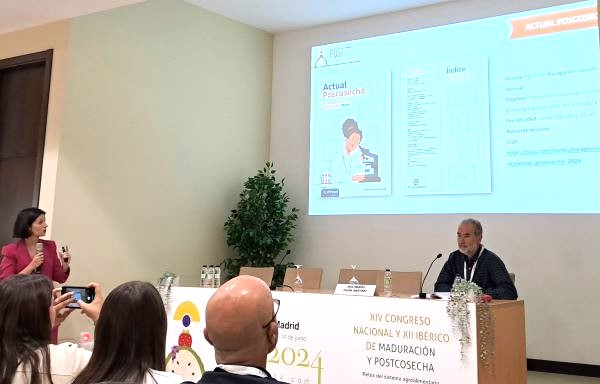
Claudia Conesa, SPE3 - Poscosecha, presenting the ACTUAL Poscosecha magazine.
The main image features the Young Researchers Group photographed after their meeting during Post2024 by our colleague Claudia Conesa.





















